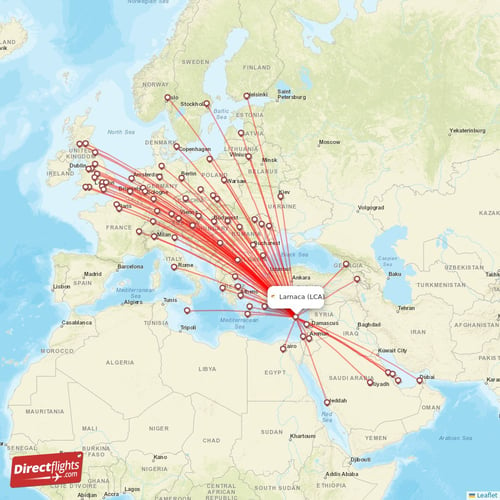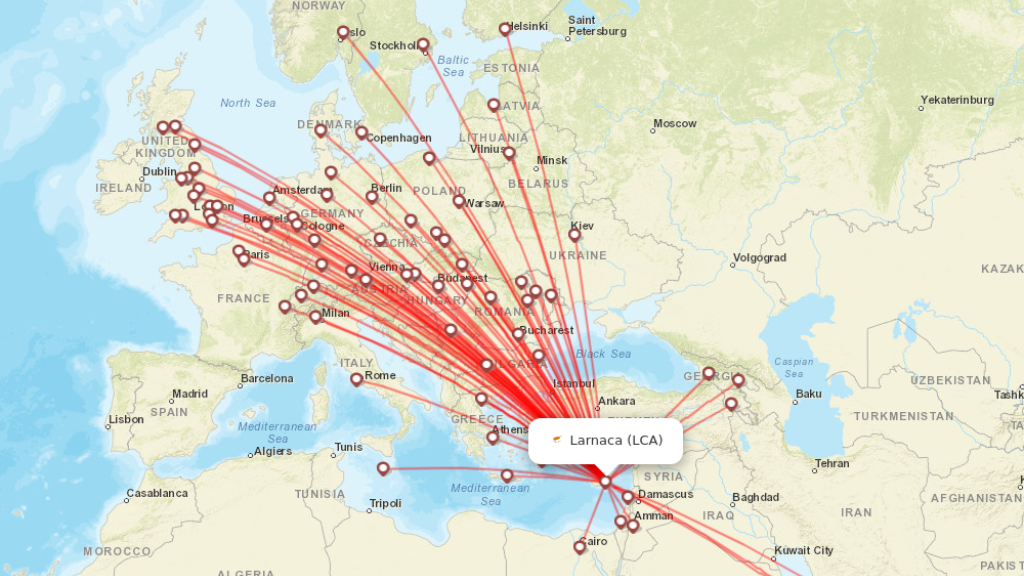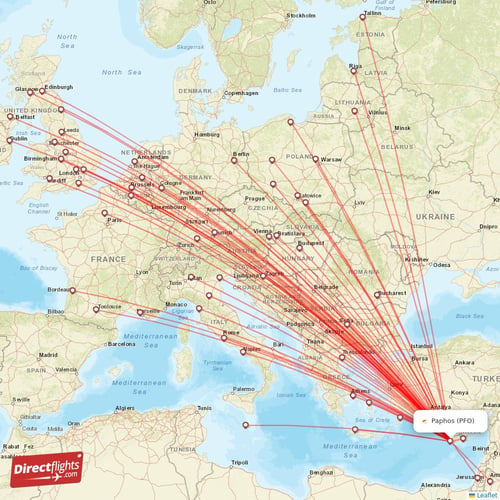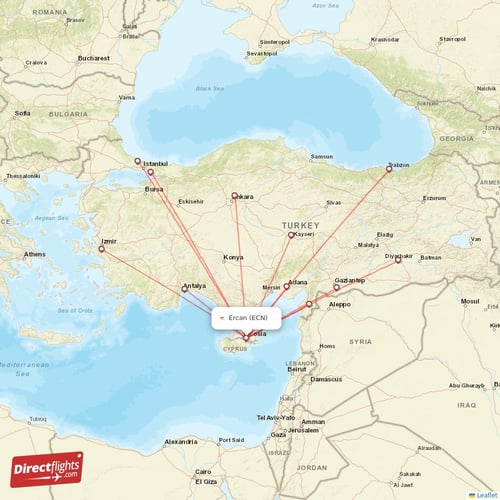Direct flights to Larnaca
Are you headed to Larnaca, Cyprus, for a vacation? Learn more about this interesting destination and find all direct flights available here.
Larnaca Airport is a medium sized and largest airport in Cyprus. In total there are 83 airports with direct flights to Larnaca from Cyprus and 35 other countries. The airport is a focus city (Operating base.) for Wizz Air. You can easily reach Larnaca with daily non-stop flights from 9 major hubs like Athens (Aegean Airlines), London (British Airways) and Vienna (Austrian).
 Click to open the interactive map.
Click to open the interactive map.
Non-stop routes to LCA:
Duration

Larnaca has a long history of tourism and the city boasts a truly stunning setting, on the southerly Mediterranean coast. Once a sleepy town, the Larnaca of today has managed to retain much of its earlier charm, whilst catering to the regular influx of sun-seeking, beach going, night-clubbing holidaymakers.
Getting to Larnaca
Larnaca International Airport is the biggest airport on the island of Cyprus and the main travel gateway to the destination. It has one terminal building that handles flights operated by major airlines from around the world.
There are a number of transport options to help travelers reach their final destination from the airport, including taxis that are available 24 hours a day from outside the main entrance. Some hotels provide shuttle bus services from the base and public buses operate to different locations in Larnaca.
Find a direct flight to Larnaca
If you want to find a direct flight to Larnaca, we can give you a hand! In the list below you find some of the airports with the most frequent direct connections to Larnaca – please follow the links to learn more about each flight option.

- Direct flights from Athens (ATH) to Larnaca (LCA)
- Direct flights from London (LHR) to Larnaca (LCA)
- Direct flights from Tel Aviv-Yafo (TLV) to Larnaca (LCA)
- Direct flights from Vienna (VIE) to Larnaca (LCA)
- Direct flights from Zurich (ZRH) to Larnaca (LCA)
Discover Larnaca
Larnaca is one of the most important urban centers in Cyprus, home to the second largest commercial port on the island and a valuable service sector.
With a population of some 72,000 people, it is the third largest city in the southern part of Cyprus after the capital Nicosia and Limassol, another popular tourist resort on the coast.
Larnaca's history dates back to the 14th century BC, when it was founded by the Greeks and known as Kition. The Athenian general Kimon died defending the city in the fifth century BC and a statue of him now stands on the seafront promenade.
As well as looking out for sights and landmarks providing an insight into local heritage, holidaymakers visiting Larnaca can explore the historic centre of the city or head to the beach to browse through shops, visit restaurants and relax by the sea.
Five must sees in Larnaca
One of the most significant locations in Larnaca is the ruin of the ancient city of Kition, which has architectural remains and features dating from the 13th century BC. Visitors can look out for the remnants of the fortified city walls and temples, one of which was devoted to the goddess Astarte.
Another historic site worth exploring is the Church of St Lazarus, a ninth century Orthodox church that was reportedly built near the place where Lazarus, the Biblical figure said to have been resurrected by Jesus, was buried for the second and final time. According to Christian tradition, Lazarus lived in this part of Cyprus for 30 years before his death.
Holiday makers interested in seeing some of Larnaca's natural sights can head west out of town towards the airport to visit a salt lake that attracts dozens of species of migratory birds from November to March every year, including thousands of pink flamingos.
Larnaca is a popular travel destination among scuba divers owing to the fact that its waters contain the wreck of the Zenobia, a ferry that capsized during its maiden voyage in June 1980. The vessel now rests on its port side at a depth of 42 meters, with the starboard side 18 meters under the water, making it suitable for newly qualified divers.
People who would rather spend their time relaxing on land can head to Phinikoudes beach, which takes its name from the word for small palm trees in the Cypriot dialect. The beach is located near a range of amenities and attractions, including small markets, restaurants, bars and cafes.
Direct flights travel tip
One of the day trip options for travelers interested in venturing beyond Larnaca is seeing a Greek Orthodox monastery that boasts a scenic location atop Stavrovouni, the hill after which it is named.
The attraction is situated 9 kilometers off the Nicosia-Limassol road, 40 kilometers from Larnaca.
When to go to Larnaca
Larnaca enjoys a warm, sunny climate with little rain throughout the year, the majority of which falls between the months of December and February.
The late spring period from April to May and early autumn months of September and October offer pleasant temperatures regularly climbing into the 20s in degrees C, while from June to August the mercury often rises into the high 20s and low 30s.
Major airlines with daily flights to Larnaca







Direct flights to Cyprus

Paphos International Airport (PFO)
Flights from 57 different airports

Ercan International Airport (ECN)
Flights from 9 different airports


